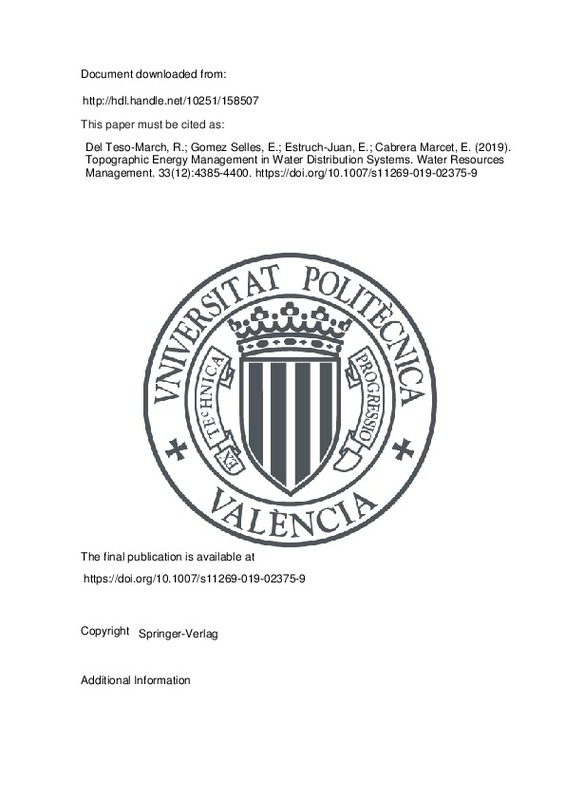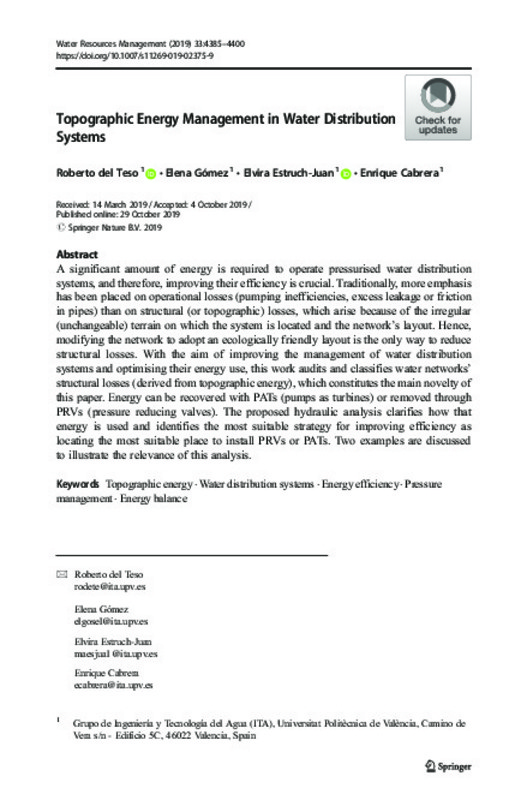JavaScript is disabled for your browser. Some features of this site may not work without it.
Buscar en RiuNet
Listar
Mi cuenta
Estadísticas
Ayuda RiuNet
Admin. UPV
Topographic Energy Management in Water Distribution Systems
Mostrar el registro sencillo del ítem
Ficheros en el ítem
| dc.contributor.author | Del Teso-March, Roberto
|
es_ES |
| dc.contributor.author | Gomez Selles, Elena
|
es_ES |
| dc.contributor.author | Estruch-Juan, Elvira
|
es_ES |
| dc.contributor.author | Cabrera Marcet, Enrique
|
es_ES |
| dc.date.accessioned | 2021-01-09T04:32:13Z | |
| dc.date.available | 2021-01-09T04:32:13Z | |
| dc.date.issued | 2019-10-29 | es_ES |
| dc.identifier.issn | 0920-4741 | es_ES |
| dc.identifier.uri | http://hdl.handle.net/10251/158507 | |
| dc.description.abstract | [EN] A significant amount of energy is required to operate pressurised water distribution systems, and therefore, improving their efficiency is crucial. Traditionally, more emphasis has been placed on operational losses (pumping inefficiencies, excess leakage or friction in pipes) than on structural (or topographic) losses, which arise because of the irregular (unchangeable) terrain on which the system is located and the network's layout. Hence, modifying the network to adopt an ecologically friendly layout is the only way to reduce structural losses. With the aim of improving the management of water distribution systems and optimising their energy use, this work audits and classifies water networks' structural losses (derived from topographic energy), which constitutes the main novelty of this paper. Energy can be recovered with PATs (pumps as turbines) or removed through PRVs (pressure reducing valves). The proposed hydraulic analysis clarifies how that energy is used and identifies the most suitable strategy for improving efficiency as locating the most suitable place to install PRVs or PATs. Two examples are discussed to illustrate the relevance of this analysis. | es_ES |
| dc.language | Inglés | es_ES |
| dc.publisher | Springer-Verlag | es_ES |
| dc.relation.ispartof | Water Resources Management | es_ES |
| dc.rights | Reserva de todos los derechos | es_ES |
| dc.subject | Topographic energy | es_ES |
| dc.subject | Water distribution systems | es_ES |
| dc.subject | Energy efficiency | es_ES |
| dc.subject | Pressure management | es_ES |
| dc.subject | Energy balance | es_ES |
| dc.subject.classification | MECANICA DE FLUIDOS | es_ES |
| dc.title | Topographic Energy Management in Water Distribution Systems | es_ES |
| dc.type | Artículo | es_ES |
| dc.identifier.doi | 10.1007/s11269-019-02375-9 | es_ES |
| dc.rights.accessRights | Abierto | es_ES |
| dc.contributor.affiliation | Universitat Politècnica de València. Departamento de Ingeniería Hidráulica y Medio Ambiente - Departament d'Enginyeria Hidràulica i Medi Ambient | es_ES |
| dc.description.bibliographicCitation | Del Teso-March, R.; Gomez Selles, E.; Estruch-Juan, E.; Cabrera Marcet, E. (2019). Topographic Energy Management in Water Distribution Systems. Water Resources Management. 33(12):4385-4400. https://doi.org/10.1007/s11269-019-02375-9 | es_ES |
| dc.description.accrualMethod | S | es_ES |
| dc.relation.publisherversion | https://doi.org/10.1007/s11269-019-02375-9 | es_ES |
| dc.description.upvformatpinicio | 4385 | es_ES |
| dc.description.upvformatpfin | 4400 | es_ES |
| dc.type.version | info:eu-repo/semantics/publishedVersion | es_ES |
| dc.description.volume | 33 | es_ES |
| dc.description.issue | 12 | es_ES |
| dc.relation.pasarela | S\396609 | es_ES |
| dc.description.references | Agathokleous A, Christodoulou S (2016) Vulnerability of urban water distribution networks under intermittent water supply operations. Water Resour Manag 30:4731–4750. https://doi.org/10.1007/s11269-016-1450-3 | es_ES |
| dc.description.references | Cabrera E, Pardo MA, Cobacho R, Cabrera E (2010) Energy audit of water networks. J Water Resour Plan Manag 136(6):669–677. https://doi.org/10.1061/(ASCE)WR.1943-5452.0000077 | es_ES |
| dc.description.references | Cabrera E, Gómez E, Cabrera E, Soriano J, Espert V (2015) Energy assessment of pressurized water systems. J Water Resour Plan Manag 141(8):04014095. https://doi.org/10.1061/(ASCE)WR.1943-5452.0000494 | es_ES |
| dc.description.references | Cabrera E, Gómez E, Soriano J, del Teso R (2019) Towards eco-layouts in water distribution systems. J Water Resour Plan Manag 145(1):04018088. https://doi.org/10.1061/(ASCE)WR.1943-5452.0001024 | es_ES |
| dc.description.references | Castro Gama ME, Quan P, Andreja J, Chiesa C (2014) Model-based Sectorization of water distribution networks for increased energy efficiency. 11th International Conference on Hydroinformatics. HIC 2014, New York City, USA | es_ES |
| dc.description.references | Ciaponi C, Creaco E (2018) Comparison of pressure-driven formulations for WDN simulation. Water 10(4):523. https://doi.org/10.3390/w10040523 | es_ES |
| dc.description.references | Covelli C, Cozzolino L, Cimorelli L, Della Morte R, Pianese D (2016) Optimal location and setting of PRVs in WDS for leakage minimization. Water Resour Manag 30(5):1803–1817. https://doi.org/10.1007/s11269-016-1252-7 | es_ES |
| dc.description.references | Creaco E, Franchini M (2013) A new algorithm for real-time pressure control in water distribution networks. Water Supply 13(4):875–882. https://doi.org/10.2166/ws.2013.074 | es_ES |
| dc.description.references | Creaco E, Pezzinga G (2018) Comparison of algorithms for the optimal location of control valves for leakage reduction in WDNs. Water 10(4):466. https://doi.org/10.3390/w10040466 | es_ES |
| dc.description.references | De Paola F, Giugni M, Portolano D (2017) Pressure management through optimal location and setting of valves in water distribution networks using a music-inspired approach. Water Resour Manag 31:1517. https://doi.org/10.1007/s11269-017-1592-y | es_ES |
| dc.description.references | EU (European Union) (2015) EU reference document good practices on leakage management. Office for Official Publications of the European Communities, Luxembourg | es_ES |
| dc.description.references | Fecarotta O, Aricò C, Carravetta A, Martino R, Ramos H (2014) Hydropower potential in water distribution networks: pressure control by PATs. Water Resour Manag 29:699. https://doi.org/10.1007/s11269-014-0836-3 | es_ES |
| dc.description.references | Giugni M, Fontana N, Ranucci A (2014) Optimal location of PRVs and turbines in water distribution systems. J Water Resour Plan Manag 140(9):06014004. https://doi.org/10.1061/(ASCE)WR.1943-5452.0000418 | es_ES |
| dc.description.references | Lambert A, Thornton J (2012) Pressure: bursts relationships: Influence of pipe materials, validation of scheme results, and implications of extended asset life. Proc., IWA Int. Specialized Conf. Water Loss 2012, IWA, The Hague, The Netherlands | es_ES |
| dc.description.references | Lambert A, Fantozzi M, Thornton J (2013) Practical approaches to modelling leakage and pressure management in distribution systems – progress since 2005. CCWI 12th International Conference on Computing and Control for the Water Industry | es_ES |
| dc.description.references | Muhammetoglu A, Nursen C, Karadirek IE, Muhammetoglu H (2017) Evaluation of performance and environmental benefits of a full-scale pump as turbine system in Antalya water distribution network. Water Supply 18(1):130–141. https://doi.org/10.2166/ws.2017.087 | es_ES |
| dc.description.references | Patelis M, Kanakoudis V, Gonelas K (2017) Combining pressure management and energy recovery benefits in a water distribution system installing PATs. J Water Supply Res Technol AQUA 66(7):520–527. https://doi.org/10.2166/aqua.2017.018 | es_ES |
| dc.description.references | Saldarriaga J, Salcedo CA (2015) Determination of optimal location and settings of pressure reducing valves in water distribution networks for minimizing water losses. 13th CCWI. Procedia Engineering 119:973–983. https://doi.org/10.1016/j.proeng.2015.08.986 | es_ES |
| dc.description.references | Walski T, Bezts W, Posluszny ET, Weir M, Withman B (2006) Modeling leakage reduction through pressure control. Journal American Water Works Association 98(4):147–155. https://doi.org/10.1002/j.1551-8833.2006.tb07642.x | es_ES |
| dc.subject.ods | 06.- Garantizar la disponibilidad y la gestión sostenible del agua y el saneamiento para todos | es_ES |









